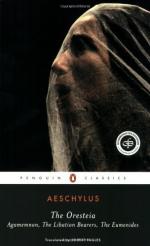|
This section contains 879 words (approx. 3 pages at 400 words per page) |

|
The Oresteia
The trilogy itself is an important object, in that it's one of the very few, and perhaps the only, surviving example(s) of the predominant form of Classical Greek theater, which is, in turn, the foundation of all historical and contemporary dramatic narrative.
Greek theater had its origins in rough-edged, unscripted religious ceremonies and festivals. As it evolved into the recounting of stories, myths and legends, it also introduced the use of actors and choruses to dramatize those stories, rather than just employing story tellers and/or clowns to tell them. The high point of this process of evolution was the trilogy, in which playwrights wrote a series of plays exploring the various thematic/spiritual/ human elements of a single myth. The Atreus stories, the Oedipus tale, and the narrative of how Prometheus came to side with humanity rather than with the gods are just a...
|
This section contains 879 words (approx. 3 pages at 400 words per page) |

|




